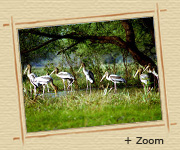 The Keoladeo Ghana National Park The Keoladeo Ghana National Park
Each year before the advent of winter in the northern hemisphere thousands of birds wing their way across the frozen waters of Siberia, Mongolia, Tibet and the high reaches of eastern Europe to the warmer subcontinent of India. One of the choicest destinations for these avians is the marsh of Bharatpur lying between the cities of Agra and Jaipur in the north-west. More than 300 species of birds are found in this small park of 29 sq. km. of which 11 sq. km. are marshes and the rest scrubland and grassland. The sanctuary derived the first part of its name (Keoladeo) from a temple dedicated to Lord Shiva situated in the central zone of the park. The other part (Ghana) of the name is a Hindi word denoting dense and thick forests. In earlier times, Bharatpur town used to be flooded regularly every monsoon. In 1760, an earthern dam (Ajan Dam) was constructed, to save the town, from this annual vagary of nature. The depression created by extraction of soil for the dam was cleared and this became the Keoladeo lake. At the beginning of this century, this lake was developed, and was divided into several portions. A system of small dams, dykes, sluice gates, etc., was created to control water level in different sections. This became the hunting preserve of the Bharatpur royalty, and one of the best duck - shooting wetlands in the world. Poaching was banned by the government in 1965 and large-scale conservation efforts began by famous ornithologist Dr. Salim Ali led the sanctuary to be declared as a National Park in March 1982. The sanctuary was accepted as a World Heritage Site by UNESCO in 1985. The Keoladeo Ghana National Park is home to an astonishing range of flora and fauna. Birds come to this national park in waves. From August through November, it is indigenous water birds. In early October the first migrants arrive from the high plateaux of Central Asia, Mongolia and Siberia, the most eagerly awaited of the lot being the gravely threatened Siberian crane. There are only two wintering places, left for this extremely rare species.One is in Feredunkenar in Iran, and the other is Keoladeo Ghana. The journey to Bharatpur takes them 6,400 kms from their breeding grounds, in Siberia. They arrive in December and stay till early March. Unlike Indian cranes, the Siberian crane is entirely vegetarian. It feeds on underground aquatic roots and tubers in loose flocks of five or six. The month of March sees most of these migrants leave the national park. But animals that have made it their home-the nilgai (blue bull), sambar, jungle cat and mongoose-spend the entire summer here. A bike or rickshaw ride through the length and breath of this sanctuary is an unforgettable experience. Most parts of the sanctuary can be reached by using bicycles or rickshaws that can be hired from the office of wildlife authorities situated at the main gate. Binoculars and English-speaking trained guides can also be hired to increase your chances of sighting a Siberian crane, the most famous of its migratory guests. With almost 377 bird species already spotted at Bharatpur, the place is certainly one of the most inviting bird sanctuaries in the world.
|
 Bharatpur Government Museum Bharatpur Government Museum
Located in the centre of the famous Lohagarh Fort, the Bharatpur Museum houses a rich collection of archaeological wealth of the nearby areas as from the old Bharatpur State. The huge palatial building Kachahari Kalan, once the administrative block of the rulers of Bharatpur state, was converted into a Museum in 1944. Later on, the Kamra Khas (personal chamber) building on the first floor was added to the museum. It exhibits sculptures found during the excavation of old villages e.g. Noh, Mailah, Bareh, Bayana etc. ranging from the Kuslian period.
|




